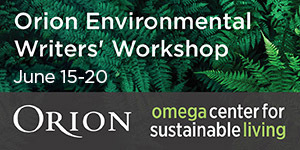SEJournal Online is the digital news magazine of the Society of Environmental Journalists. Learn more about SEJournal Online, including submission, subscription and advertising information.
 |
 |
| Climate “nature-solutions” reporter Gabriel Popkin with an evergreen Araucaria tree. |
Inside Story: Reporter Unravels Complex Dynamic Between Climate Change and Nature
A series of stories on nature-based solutions to climate change led Gabriel Popkin to an honorable mention for Outstanding Beat Reporting, Large, in the Society of Environmental Journalists' 21st Annual Awards for Reporting on the Environment. His stories focused on topics like the booming business of fuel pellets — as a climate solution or as a source of more pollution — as well as the transformation in the field of soil sciences, the struggle to maintain grasslands in the Great Plains and the future of coastal wetlands. Judges praised his work, saying that “in every case, he demonstrated his penchant for identifying flashpoints, his narrative skill, and his ability to explain complex topics in an engaging and accessible manner.” SEJournal Online recently conducted an email interview with Gabriel Popkin. Here is the conversation, edited for clarity and brevity.
SEJournal: How did you get your winning story ideas?
Gabriel Popkin: In recent years, there has been a lot of talk about nature-based climate solutions, with many organizations, politicians and corporations getting behind the idea that forests, soils and other ecosystems can take up large amounts of carbon dioxide and help bail us out of our climate change problem, while allowing us to avoid painful sacrifices. At the same time, I knew from years of reporting that nature is complicated and that modern ecosystems are beset with all kinds of challenges — including climate-related ones — that may prevent them from behaving cooperatively with our natural climate solutions schemes. I found myself investigating one story after another where climate and natural systems were interacting in ways that confounded simple narratives. Although the individual stories were not related, I eventually realized they were thematically similar enough to constitute a beat of sorts.
SEJournal: What was the biggest challenge in reporting the pieces and how did you solve that challenge?
Popkin: I would say striking the right balance. In the New York Times story on wood pellets, I was lobbied intensely by both representatives of the main wood pellet company and NGOs opposing the pellet industry to tell their side of the story. The truth, as always, was somewhere in the middle, and I think I got it right. Similarly, in the soils story, I needed to show how many claimed soil-based climate solutions are founded in false scientific narratives, while making clear that there is still some scientific basis for the overall idea of soil-based climate solutions. For the “Forest Fight” story, I needed to find sources in Germany, a country I'm less familiar with than the U.S., and to interview sources who often spoke poor English. I also made hefty use of automatic translating apps, which have gotten quite good.
SEJournal: What most surprised you about your reporting?
‘I was continually surprised that
things are always more complicated
on the ground than I expect.’
Popkin: I was continually surprised that things are always more complicated on the ground than I expect, how easy it is for narratives that are untrue or drastically oversimplified to nevertheless become widespread and accepted as fact (and reported as such in the media), and how readily some people will say things to a reporter that are obviously false or misleading — especially when a lot of money is at stake. I was also surprised that NGOs and activists, and sometimes even academics, can be as brazen as corporations in promoting false or misleading narratives. We expect this from corporations but less from nonprofits, which often have a sort of sheen of benevolence around them that perhaps isn't always merited.
I was also surprised at how often sources don't end up being able to deliver the goods they promised. For the grassland-to-cropland conversion story, for example, a number of people suggested they could connect me with farmers doing the conversion, but in the end, no one came through. Similarly, in the wood pellets story, environmental advocates claiming they could show me damage that pellet makers were doing to environmentally sensitive wetland forests were unable to provide convincing recent evidence. On the other hand, the pellet company I was in touch with was also unable to connect me with a landowner actively harvesting their forest. I had to find one via another source, which ended up providing sort of the human heart of the story.
SEJournal: How did you decide to tell the series and why?
Popkin: For each story, I tried to situate the reader directly in a scene illustrating the central tension, and then pull back to add context and background. I think this is a pretty standard storytelling technique and I don't know that I made any major narrative innovations in this series. The one exception is the soils story, which did not include field reporting and did not lend itself to the same approach. In this case, I went straight to the heart of the matter — a lot of people hope soils can help save the climate, but new science calls this idea into doubt.
SEJournal: Do the issues covered in your stories have disproportional impact on people of low income, or people with a particular ethnic or racial background? What efforts, if any, did you make to include perspectives of people who may feel that journalists have left them out of public conversation over the years?
Popkin: The wood pellets story opens with a scene showing the direct impact of a wood pellet production facility on a nearby family. Previous stories on the topic often featured a well-known environmental activist in the area, but when I visited her, it became clear that she lived some distance from the factory and was not personally impacted by the pellet industry in a very direct way. It took several additional steps to locate someone who was actually on the "front lines," so to speak, but the effort was worth it. I have to credit the photographer I worked with for making the connection to the source we ended up featuring. A number of people have written to me since, wanting to learn more about the environmental justice impact of the pellet industry, so it's clear this choice of opener had an impact on readers.
SEJournal: What would you do differently now, if anything, in reporting or telling the series and why?
Popkin: One regret I have is not locating a farmer in South Dakota who was actively converting grassland to cropland, which would have allowed me to explain what incentives were driving them to do that. Instead, I mostly had sources offering opinions on why other people convert grasslands. In retrospect, I wish I could have spent more time on the ground developing sources in a region where I really didn't have any before taking on this project.
SEJournal: What lessons have you learned from your stories?
Popkin: Five critical factors for producing original, impactful journalism: time, money, supportive editors, a skeptical and rigorous approach and an open mind.
SEJournal: What practical advice would you give to other reporters pursuing similar projects, including any specific techniques or tools you used and could tell us more about?
‘Do your own research and reporting,
and don't assume a particular narrative
is correct unless you've verified it yourself.’
Popkin: My main advice is to do your own research and reporting, and don't assume a particular narrative is correct unless you've verified it yourself. If you're feeling doubt about something you've been told or read, reach out to additional sources who can either assuage or confirm your doubts. Don't be afraid to write a story that contradicts or questions the standard media narrative — even we journalists don't always get things right, especially when we're not given the resources to fully report a story.
Also, Twitter (long may it live) can be your friend. My soil story started thanks to a tweet I read, which called into question a major project that previously had received nothing but puff pieces, including from some of the country's most influential media outlets.
SEJournal: Could you characterize the resources that went into producing your prize-winning reporting (estimated costs, i.e., legal, travel or other; or estimated hours spent by the team to produce)? Did you receive any grants or fellowships to support it?
Popkin: Each story except the soils one involved a several-day field reporting trip, in addition to the usual follow-up phone reporting, writing, editing, etc. None required an extraordinary investment of resources. The grassland story was supported by the Food and Environment Reporting Network, which partnered with National Geographic to publish it. The “Forest Fight” story benefited from an Arthur F. Burns reporting fellowship which allowed me to spend two months in Germany.
SEJournal: Is there anything else you would like to share about these stories or environmental journalism that wasn’t captured above?
Popkin: I worry that environmental journalism has been somewhat "captured" by activists and environmental advocates who present themselves as speaking "truth" to evildoing corporations and politicians. While NGOs and advocacy organizations certainly have a valuable role to play in public discourse, the more I do this work, the more I find that they too often distort or massage facts to further their agendas. I think we as a community need to be more skeptical of appealing but oversimplified or misleading narratives, and ensure that we're really delivering accurate, balanced, fact-based stories to our readers.
Unfortunately, I continue to read stories suggesting the wood pellet industry is wiping out vast wetland forests in the Southeast (not true) or that there are forms of carbon that can last for centuries or millennia in soils (also not true). Another common environmental journalism error is to equate logging with deforestation and/or to portray all logging as environmentally destructive, essentially substituting anti-logging activist slogans for journalism. We need to evolve our profession to handle complex topics with the nuance and subtlety they and our readers deserve.
Gabriel Popkin is an award-winning science and environmental journalist who writes often about nature, climate and the relationship between the two. He has written for The New York Times, Science, The Washington Post, National Geographic and many other outlets. He has previously written for SEJournal on a grant-based project on ash trees, wetlands and basket weaving, and on tensions between food production and biodiversity. He lives in Mount Rainier, Maryland, just outside the nation's capital.
* From the weekly news magazine SEJournal Online, Vol. 8, No. 44. Content from each new issue of SEJournal Online is available to the public via the SEJournal Online main page. Subscribe to the e-newsletter here. And see past issues of the SEJournal archived here.













 Advertisement
Advertisement 




